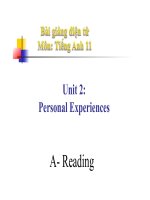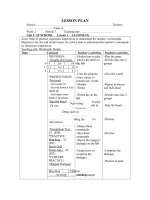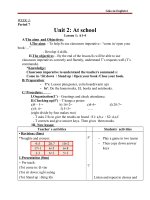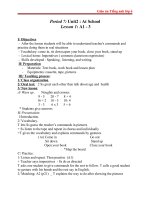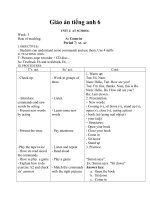Giáo án Tiếng Anh 11 Unit 2: Personal experiences
Bạn đang xem bản rút gọn của tài liệu. Xem và tải ngay bản đầy đủ của tài liệu tại đây (216.94 KB, 44 trang )
Giáo án Tiếng Anh 11
UNIT 2 : PERSONAL EXPERIENCE
LESSN 1: Reading
I. Objectives
By the end of the lesson, Ss will be able to:
- Develop such reading micro-skills as scanning for specific ideas,
identifying the sequence of events and guessing meaning in context.
- Use the information they have read to discuss the story.
II. Materials
Textbook, handouts.
III. Anticipated problems
Ss may need help with the discussion task, so T should be ready to help
them.
IV. Procedure
Time
Steps
Work
arrangement
5’
WARM UP
Vocabulary crossword puzzle
- T divides the class into small groups 0f 3 – 4 Ss. Then
Group
work
whole class
and
T distributes the following crossword puzzle handouts
for Ss to do in their own groups. Which group finishes
first and has all the correct answers will be the winner.
Crossword
1. My dad works in a factory where he produces
cars and tractors. He’s and ...
2. An ........ is something that protects you from rain
or sun.
3. He saved 5 people in the fire. He’s such
a......person.
4. We have a big ...........for our cars and a lovely
garden at home.
5. This is a beautiful song. I like both the music and
the ....... .
6. Tran Hung Dao is a national....... . He saved the
Vietnamese people from Chinese invaders.
7. He wom several chess championships at a young
age.
Actually,
he
was
the
the
country’s
youngest ........ .
8. In her glorious singing career Celine Dion has
earned various music awards. She is the
most ...........Canadian singer.
9. Only a little boy saw the car hit and run. He was
the only .....of the accident.
10. Washington DC is the ............city of the United
States.
11.My flat is quite ..... : it’s located right in Hoan
Kiem District, the city centre.
12. My mother always ..........me to go ahead and
realise my dreams.
Answer:
e
g i
n
e
e
m b
r
e
l
l
a
b
r
a
v e
g
a
r
a
g e
y
r
i
c
s
h e
r
o
c
h
a
m p i
u
l
s
e
n
u
c
c
e
s
s
w i
t
n e
s
s
c
a
p
i
c
e
u r
a
n c
o
o
f
u l
t
a
l
n
t
r
a
g
e
s
r
n
l
- T explians the word “embarrassing” and introduces the
topic: An embarrassing situation
5’
BEFORE YOU READ
- T gets Ss to work in pairs and try to make sense of the
pictures on page 22. Then T gets them to put the pictures
Pair work and
whole class
in the order that they think is most appropriate.
- T calls on some pairs to present their ideas but should
not correct them. If Ss have difficulty talking about the
pictures, T may elicit their answers by asking questions
and giving prompts.
E.g: What can you see in picture A ? What do you think
might be relationship between the girl and the man ?
Why ? What do you see on the table ? Whose money do
you think it is ?
5’
WHILE YOU READ
Pair work
Set the scene: You are going to read a story in which a
girl’s telling about her most embarrassing situation.
Then you do the tasks that follow.
TASK 1
8’
- T gets Ss to read the passage silently and then do Task
1. T may write the given words and phrases on the board
(i.e. making a fuss, sneaky, glanced, embarrassing,
idols) and asks Ss to go back to the passage to locate
and read around these words so that they can guess their
meanings. For example. The words “idol” found in line
3 may refer to “someone you admire and adore”. Ss can
understand this meaning thanks to the words “pop star”
and the idea that the girl wants to look like this person.
- T might want to check that Ss understand all these
Individual work
& whole class
words correctly by calling on some Ss to tell the
meaning of the words in Vietnamese .
- Then T asks Ss to go back to the task and study the
given sentences . Ss need to guess which part of speech
they might deal with in each case . For example , for
sentence 1 they might need to supply a verb in past tense
or for sentence 2 they might need to supply a verb in
present continuous, etc .
- Now Ss use both their knowledge of the word in the
box and their guess – work with the given sentences to
match them correctly .
- T chck the anwers with the whole class .
Answers :
1 . glanced
2 . marking a fuss
3 . embarrassing 4 .
idols 5 . sneaky
TASK 2 :
5’
- T gets Ss to read the text silently again and then with a
peer work out the sequence of the picture given on page
22 again, this time based on the information in the text.
- T calls on a student to give and explain his/her answer.
- T gives corrective feedback
Answer: 1. Picture d 2. Picture b 3. Picture f
4.
Picutre e 5. Picture a 6. Picture c
TASK 3
- T ckecks if student can answer the comprehension
questions in Task 3 without having to read the passage
again. If Ss cannot, T gets them to read the questions
carefully and gives them some tips to do the task.:
+ First, Ss should skim the five questions to
understand them. As Ss do this they:
* underline the key words to decide what information
they nedd to find in the text
* look for questions words like “why” which indicates
Ss should read for specific thingmlike a reason.
+ Then they should go back to the passage and locate
the key words in the passage.
+ Them they should read around the key words
carefully to find the answer.
- T gets Ss to check their answers with a peer.
- T calls on some Ss to write their answers on the board
and ask them to explain their choices.
- T gives the correct answers:
Answer:
1. A floppy cotton hat (lines 2-3, paragraph 1)
2. To buy a floppy cotton hat (lines 1-2, paragraph
2)
3. A wad of dollar notes that look exactly like those
her father had given her. (lines 2-3, paragraph 3)
4. She thought that was her own money and the boy
had stolen it from her. She wanted to take it back
without making a fuss. )lines 3-6, paragraph 3)
5. She bought the hat of her dream. (line 1,
10’
paragraph 4)
AFTER YOU READ
- T introduces the task: Ss work in small groups of 3 or 4
and discuss the questions.
- T teaches some structures that can be used for giving
suggestions. E.g. “perhaps she could”, “she might want
to ...” and some adjectives that express feelings, e.g.
“embarrassed”,“ashamed”,“confused”,“sad”,
“unhappy”, “uncomfortable”, “uneasy”, etc.
-T goes around to check and offer help.
-T calls on the groups to tell and explain their choice.
-T gives corrective feedback.
Suggested answers:
1. She might feel embarrassed and guilty/ashamed
because that was not her money.
2. Perhaps the girl could place a notice on a local
Group work &
whole class
newspaper to apologize the boy and contact him
to give him the money back/ Perhaps the girl
might want to her father the truth and ask him for
help/Perhaps the girl could come to the police
station, tell the police the truth and ask them for
help/ May be the girl could get on the same bus
the next day and look for the boy to return him the
money, etc.
2’
WRAPPING UP
-T summarises the main points of the lesson.
-For homework, T asks Ss to learn by heart the new
vocabulary and make sentences with them.
UNIT 2 : PERSONAL EXPERIENCE
LESSON 2: Speaking
I. Objectives
By the end of the lesson, Ss will be able to:
- Identify structure that are used to talk about past experiences and their
influences on one’s life, i.e. present perfect and past simple, structure with ‘Make’.
-Use these structures to talk about a past experience and how it affects their life.
II. Materials
Textbook, handouts.
III. Anticipated problems
Ss may have problem using present perfect and past simple when talking about the
past.
IV. Procedure
Time
Steps
Work
arrangement
10’
-Have you ever - Game
This is game for student to practise making “Have you
ever ...” questions , and responding to them . To prepare
for it , at home T cuts out and shuffles the given “Tell th
Truth ” or “Tell a lie” cards .
- T first divides the class into groups of 3-4 . Then T
places the cards in one pile at the centre of the table .
- T models “Have you ever ” + past participle for Ss as
well as ways to respond to “Have you ever ” questions.
E.g
Have you ever sung in public ?
Yes , I have or No , I haven’t .
If the answer is “Yes ” , no might ask a follow-up
questions , using the past simple , e.g . When was it ?
Where did you sing ? etc .
- Now T introduces the game : Within their group the first
student starts and asks anyone else in his / her groudp a
“Have you ever questions .” . The student who is asked
the questions should draw a card from the pile of “Tell a
Lie ” card and answer according to the card . The rest of
the student are allowed to ask 3 more follow- up
questions to try and determine if the person answering is
telling the truth or lying . After 3 questions are up , the
student answering will show his / her card for the group to
see if it’s a “Tell the truth ” or “tell a lie ” card . The
groud continues to play until everyone is asked .
Tell the truth
Tell a lie
Tell the truth
Tell a lie
Tell the truth
Tell a lie
Tell the truth
Tell a lie
Tell the truth
Tell a lie
Tell the truth
Tell a lie
Tell the truth
Tell a lie
TASK 1
T introduces the task and gets Ss to do it individually ,
then copare the answers with a peer .
- T calls on a student to read out his / her answers .
10’
- T checks with the class and gives corrective feedback .
Individual
work ,
pair
- T intriduces or elicits the structures “Make some body work & whole
class
do something ” or “ Make somebody + Adjective ”.
- T writes the structures on the board and elicits their
meaning and uses
- T gets Ss to make sentences with the strutures or ald
more options to Column B .
Note : T should make it clear to Ss that when a verb is
used as a subject , it should take the form of either an
infinnitive with “to ” or – ing gerund .
E. g “to speak English to a native speaker makes you
more interested in learning English ” or “Speaking
English to a native speaker makes you more interested in
learning English ”
Answers :
1. d
2.c
3. a
4. d
5. e
TASK 2
- T introduces the task : Ss are going to work
individuallyon the sequence of the conversation and then
find a peer to compare theur answers with .
- T call on a student to read out his / her answers .
10’
- T checks with the class and gives corrective feedback .
- T draws Ss’ attention to the questions asked in the
conversation and help them to review the use of present
perfect and past simple when talking about a past
experience and its present effeccts .
Present perfect : used with “ever ” to ask about a past
experience.
E.g: “Have you ever been to Egypt ?”.
Past simple: used when one keeps asking about that
experience.
E.g: When did you go there ? Who did you go with ? Did
you enjoy your visit to Egypt ? etc.
- T gets Ss to ask him/her questions using present perfect
with “ever” and past simple.
-T checks that Ss asks correct questions and gives
corrective feedback.
-Then T gets Ss to read the sample conversation in closed
and open pairs.
Answers: 3. h
4. a
5. e
6. g
7. c
8. f
12’
TASK 3
- T introduces the task: Ss are going to ask and answer
Pair work &
whole class
questions about their past experiences, using the
suggested questions on page 26.
- T gets Ss to work in pairs to have a conversation. In the
meantime, T goes around to check and offer help.
- T calls on some pairs to perform their conversations in
front of the class.
- T elicits feedback from the class and gives final
comments.
3’
WRAPPING
- T summarises the main points of the lesson.
- For homework, Ss write a paragraph about a past event
that has had an influence on him/her.
UNIT 2 : PERSONAL EXPERIENCE
Whole class
LESSON 3 : Listening
I. Objectives
By the end of the lesson, Ss will be able to develop such listening microskills as listening for specific information and taking notes while listening.
II. Materials
Textbook, cassette tapes, handouts.
III. Anticipated problems
Ss may not have sufficient vocabulary to talk about the topic, so T should be
ready to assist them. Ss may not also be familiar with the note-taking task so
T should provide them some tips to deal with the task.
IV. Procedure
Time
Steps
5’
WARM UP
A matching game
(To teach vocabulary related to fires and lead Ss to
the topic )
- T divides the class into small groups of 3 - 4
students . Then T distributes the following handouts
for Ss to do the matching task in their own groups .
Which group finishes first and has all the correct
answers will be the winner .
- T might want to get Ss to translate the given words
Work arrangement
Group work & whole
class
into Vietnamese to check Ss’ understanding of the
words
Match the words in Column A with their definitions
in Column B
Column A
Column B
1 . Fire fighter
a. A metal stairway
outside to help people
get out of a buiding on
fire
2 . Fire alarm
b. A pipe that draws
water for putting out a
fire .
3 . Fire door
c. A person who fights
fires
4 . Fire escape
d. What comes out of a
fires
5. Fire hydrant
E . A fine – resistant
door that can be closed
to stop the speard of the
fire
6. Fire extinguisher
f. A large truck that
carries firefighters and
equipment to the site of
a fire
7. Smoke
g. A tube that contains
special chemicals for
putting out a fire
8 . Fire truck
h. A bell that tells you a
fire has started
Answer :
1.c
2.h
7 .c
8. f
10’
3.e
4. a
5. b
6. g
BEFORE YOU LISTEN
- T gets Ss to work in pairs to describe the picture on
page 27 of the textbook.
- T calls on some Ss to describe the picture. If Ss
have difficulty doing this task, T may want to elicit
answers from the whole class by asking questions
like “What can you see in the picture ?” “What is
happening ?”, “Who are these people ?” etc. T gives
comments on their answers.
- T gets Ss to guess what they are going to listen
about.
Pre-teaching vocabulary
Memorable (a):
Terrified (a):
Scream (v):
Pair work and whole
work
Replace (v):
Gas stove (n):
Embrace (v):
Escape (v):
Protect (v):
- Before teaching these words, T helps Ss to
pronounce them correctly. T may want to play the
tape or model first and then ask Ss to repeat after the
tape or after him/her in chorus and individually.
- T presents or elicits the meanings of these words
from the class.
- T gets Ss to make sentences with some important
words, e.g: memorable, scream, protect etc ...
- T gives corrective feedback.
10’
WHILE YOU LISTEN
Task 1
Instruction: You are going to listen to a girl telling
about her most unforgetable experience. Listen and
answer True or False questions. Put a tick in the
appropriate box.
- Before Ss listen and do the task, T gets them to read
through the statements to understand them and
Individual
work,pair
work and whole class
underline key words. For example, the key words in
the
first
statements
are
“Christina”
and
businesswoman”.
- T checks with the whole class and asks them to
guess what the unforgetable experience the girl is
going to tell might be(a fire).
- T plays the tape (or reads the tapescript) once for Ss
to listen and do the rask.
- Then T gets Ss to find a partner to check their
answers with.
-T checks the answers with thw whole class. If many
Ss can not answer the questions, T palys the one or
two more times and pauses at the answers for them to
catch.
Answers: 1. T
2. F (13 years old) 4. F(in the
kitchen) 4. F (she was sleeping) 5. T
TASK 2
Instruction: You are going to listen to the story
again and fill the gap with the information you hear.
- T checks if Ss can do the task without listening one
more time. If they can’t , T plays the tape again. But
before doing it, T asks Ss to study the text carefully
for the missing information they need to fill and
guess the answers. T might also want to remind Ss
that while listening they need to focus on this
information and write the answers down in note
forms, not full sentences.
- After playing the tape, T gets Ss to give the
answers. T provides correct answers if necessary. If
many Ss can’t complete the task , T might want to let
Ss listen one more time and pause at the answers fir
them to catch.
Answers: 1. small 2. everything
3. family
4.
replaced 5. took
6. appreciate
Tapescript: (In T’s book)
Interviewer: This is Radio 3. Inour “Unforgetable
Experiences” programmme tonight we talk to
Christina, a successfulbusinesswoman. Hello
Christina, welcome to our programme.
Christina: Hello and thank you ! It’s nice being with
you tonight.
Interviewer: Christina, could you tell our audience
about the most memorable experience in your life ?
Christina: Well, my most unforgetable experience
happened 13 years ago, when my house burned
down.
Interviewer: Really ? How did it happen ?
Christina: The fire started in the kitchen where I
forgot to turn off the gas stove.
Interviewer: What were you doing at that time ?
Christina: I was sleeping when I was suddenly woken
up by terrible heat.I opened my eyes to find myself
surrounded by wall of fire.
Interviewer: That’s terrible. How did you escape ?
Christina: I was terrified. Then I heard my mother’s
voice calling my name. I rushed to her. She carried
me out. Luckily, I got away without even a minor
burn.
Interviewer: Not many people are so lucky. Did the
fire affect you in any way ?
Christina: Oh, yes. Yes, very much, in fact. Although
I lost many things in the fire, the experience helped
me to grow up.
Interviewer: What do you mean ?
Christina: Well, before the fire I was selfish. I always
complained to my mother about how small my room
was, or how few clothes I had. Then the fire came
and destroyed everything we owned. But I slowly
began to realise that I didn’t really need my old
things. I just needed my family. After all, you van get
new clothes anytime, but a family can never be
replaced.
7’
AFTER YOU LISTEN
- Before getting Ss to discuss, T teaches them some
useful expressions of asking for and giving opinions.
E.g:
Asking for opinions
What do you think about ?
What’s your opinion about ?
What’s your feeling about ?
What’s your point of view about ?
How do you feel about ?
Do you have any opinions about ?
Expressing
Expressing
Expressing
opinions
agreements
disagreements
I think ...
I agree
Well, may be,
Personally,
I think so, too
I believe...
That’s
true,
but ...
That might be
Group work & whole
class
I feel...
and ....
In my opinion, That’s
From
my
point
of
true, but ...
right, Well, my feeling
and ....
is that ...
Well,Idon’t think
view...
so. I think ...
- T gives examples and gets Ss to do some practice
with these structures.
- Now T divides the class into small groups of 3 or 4
and gets them to discuss the question in the textbook.
T might want to appoint a group leader for eacg
group. This person will monitor thr discussion, note
down friend’s ideas and appoint a representative to
present the outcome of their discussion to the class.
- T goes around to check and offer help.
- After checking that all the groups have finished, T
calls on the representative of each group to report
their peer’s ideas. T checks if other groups would
have the same or different ideas.
- T listens and takes note of their errors. T provides
corrective feedback after that.
3’
WRAPPING
- T summarises the main points of the lesson.
- For homework, Ss write a summary of the story
Whole class
they listened in class.
UNIT 2: PERSONAL EXPERIENCE
LESSON 4: Writing
I. Objectives
By the end of the lesson, Ss will be able to write a personal letter telling
about a past experience , using the structures and vocabulary that they have
learned in previous lessons.
II. Materials
Textbook, handouts.
III. Anticipated problems
Ss may not have sufficient vocabulary to write about the topic, so T should
be ready to help them.
V. Procedure
Time
Teacher’activities
Sts’ activities
5’
WARM UP
A quiz about writing personal letters
(To remind Ss of the rules of writing personal letters in
English)
- T asks Ss if they have ever written a personal letter in
English and then announces the Quiz game and the rule.
For example: “I’m going to divide the class into 2 big
groups . Then I’m going to read out some questions
about the rules of writing personal letters in English. You
need to give your responses as quickly as possible. For
each question, if your answer is quicker and correct, you
get one point for your group. Then we will add up the
points for each group. Which one has more points will be
the winner”.
- T divides the class into 2 big groups: A and B.
- T reads out the questions and leads the game.
The Quiz
1. How many parts does a personal letter normally
have ?
2. What are these parts ?
3. What do we normally write in the Salutation ?
4. What do we normally write in the Closing ?
5. Where do we normally sign the letter ?
- T gets Ss to add up the points for each group and
Whole class

